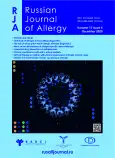Aeropalynologic monitoring of air pollution in the Rostov region: the results of the 2019 season
- Authors: Churyukina E.V.1, Ukhanova O.P.2, Goloshubova E.А.2
-
Affiliations:
- Rostov State Medical University
- Stavropol State Medical University
- Issue: Vol 17, No 4 (2020)
- Pages: 57-65
- Section: Original studies
- URL: https://journals.rcsi.science/raj/article/view/121594
- DOI: https://doi.org/10.36691/RJA1387
- ID: 121594
Cite item
Full Text
Abstract
BACKGROUND: There is an increase in the proportion of patients suffering from allergic diseases caused by the plant pollen. Aeropalinologic monitoring of the air environment allows us to study the composition of aeroallergens and their role in the formation of pollen allergies. Features of the formation of aerial pollen spectra are closely related to the botanical-geographical and natural-climatic conditions of the region. The Rostov region has its own specific features, which is reflected in the qualitative and quantitative composition of pollen rain.
AIM: To study the dynamics of pollination of allergenic plants in Rostov-on-Don, identify the prevailing taxa and create a calendar of pollination of plants for this region.
MATERIALS AND METHODS: Aeroallergens were detected by using a volumetric Burkard trap. The identification of plant pollen and fungal spores was performed by microscopy of colored slides obtained from a sticky tape covered with a special mixture.
RESULTS: In 2019, 21 taxa were registered in the air environment of Rostov-on-don (trees, meadows, haze, cereals, weeds), fungal spores were found in the air, represented by the mold fungi Cladosporium herbarum and Alternaria alternata in high growing concentrations. An increase in the vegetation period of pollination of trees (07.03.–31.06), mares (02.05–03.10), cereals (02.04–14.09), weeds (18.07–28.10) was detected According to the dynamics of pollen concentration, three periods of its growth were registered: spring-summer, summer and summer-autumn. The presence of birch pollen grains in a clinically significant concentration (36 pollen grain (PG)/m3) in this steppe region, an increase in the peak concentration of ragweed (393 PG/m3) in comparison with the same data for 1971 (265 PG/m3) was found.
CONCLUSION: Regional features of the spectrum of air allergens were identified, and a dusting calendar was compiled for Rostov-on-Don.
Full Text
##article.viewOnOriginalSite##About the authors
Ella V. Churyukina
Rostov State Medical University
Author for correspondence.
Email: echuryukina@mail.ru
ORCID iD: 0000-0001-6407-6117
Head of Division for Allergic and Autoimmune diseases, PhD, Docent
Russian Federation, Rostov-on-DonOlga P. Ukhanova
Stavropol State Medical University
Email: uhanova_1976@mail.ru
ORCID iD: 0000-0002-7247-0621
Professor of the Department of Clinical Immunology, MD, PhD
Russian Federation, StavropolElena А. Goloshubova
Stavropol State Medical University
Email: Elena_goloshubova@mail.ru
ORCID iD: 0000-0001-8410-7080
Post-graduate Student of the Department of Clinical Immunology, the allergist-immunologist, aerobiologist
Russian Federation, StavropolReferences
- Il’ina NI. The epidemic of allergies – what are the reasons? Rossiiskii Allergologicheskii Zhurnal. 2004;(1):37–41. (In Russ.).
- Agache I, Akdis CA, Chivato T, et al, editors. EAACI White paper on Research, Innovation and Quality Care. Switzerland: EAACI; 2018.
- Sofiev M, Bergmann KCh. Allergic pollen. A Review of the production, release, distribution and health impacts. Dordrecht: Springer; 2013. doi: 10.1007/978-94-007-4881-1
- D’Amato G, Spieksma FM. European allergenic pollen types. Aerobiologia. 1992;8(3):447–450. doi: 10.1007/bf02272914
- Howard LE, Levetin E. Ambrosia pollen in Tulsa, Oklahoma: aerobiology, trends, and forecasting model development. Ann Allergy Asthma Immunol. 2014;113(6):641–646.doi: 10.1016/j.anai.2014.08.019
- Breton MC, Garneau M, Fortier I, et al. Relation-ship between climate, pollen concentrations of Ambrosia and medical consultations for allergic rhinitis in Montreal, 1994–2002. Sci Total Envirion. 2006;370(1):39–50.doi: 10.1016/j.scitotenv.2006.05.022
- Pingping Y, Jiandong L, Hong Y. Impact of Ambrosia trifida invasion plant biodiversity. Journal of Northwest Sci-Tech University of Agriculture and Forestry. Natural science edition. 2010;38(4):189–194. (In Chinese).
- Churyukina EV. Role and place of intranasal corticosteroids in the treatment of allergic rhinitis at the present stage. RMZh. 2019;27(3):51–56. (In Russ.).
- Meier-Melikyan NR, Severova EE, editors. Principles and Methods of Aeropalinological Research. Moscow: Meditsina; 1999. (In Russ.).
- Rakova KA. Pollinozy goroda Rostova-na-Donu [dissertation]. Krasnodar; 1977. (In Russ.).
Supplementary files












